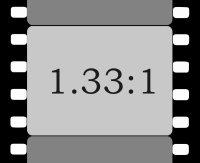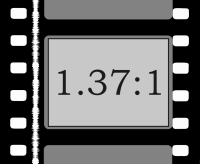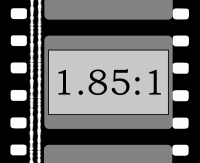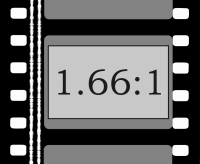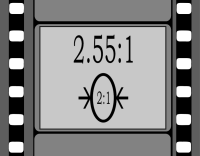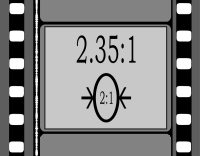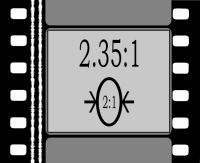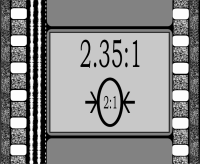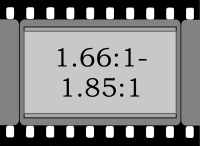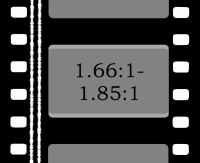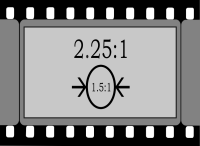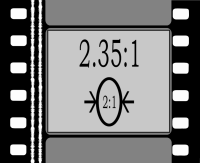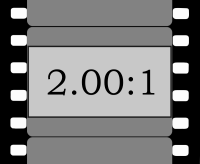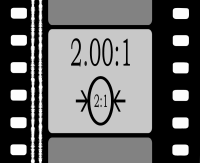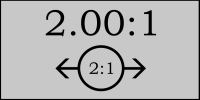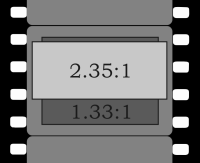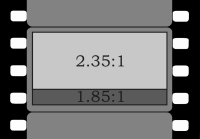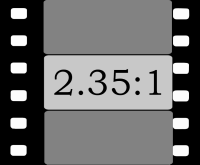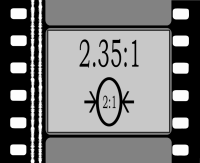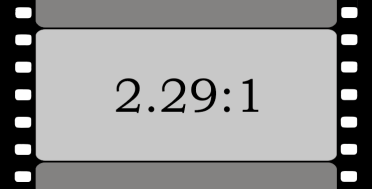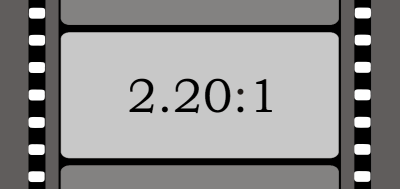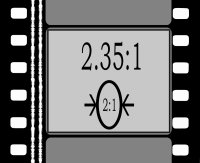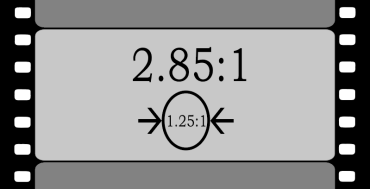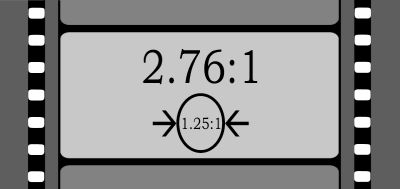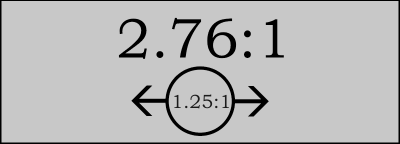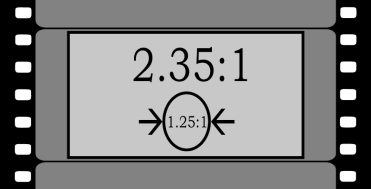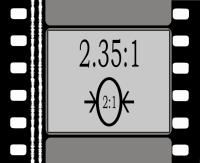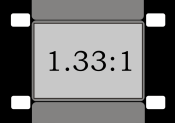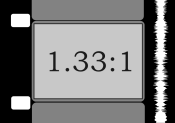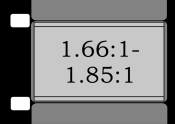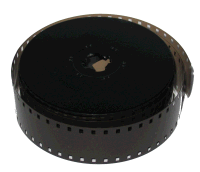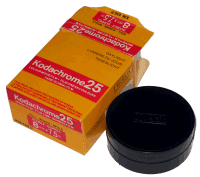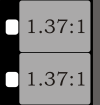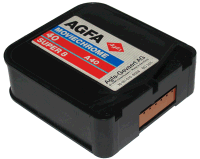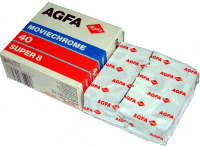|
Film Format Guide |
| The
DVDLog Film Format Guide is an extensive overview of current and historic
film formats.
This list is not complete because not every rare format has been included,
but all major systems are represented.
More information about film formats with much original material is available
at the American Widescreen Museum.
|
|
Silent Film |
| Years: |
1893 - ca. 1932 |
| Aspect Ratio: |
1.33:1 |
| Camera & Projection Lens: |
spherical |
| Full Aperture Size: |
0.980" x 0.735" (24.9 x 18.7 mm) |
| Used Aperture Size: |
0.980" x 0.735" (24.9 x 18.7 mm) |
| Running Speed: |
16 - 24 Frames per Second |
| Sound: |
none |
35mm silent film has its roots in the early Kinetoscope-experiments
of Thomas Edison, who already used a film strip around 1890 which was
nearly identical to the 35mm-filmstock in use today and despite some competition
became a worldwide standard.
|
|
The frame of the early silent movies had a height of four sprocket holes
and the whole exposed frame was usually projected. The running speed was
variable, because early movie cameras had no motors and were powered by
a hand crank. This resulted in speeds between 16 and 25 frames per second,
so that many movies from this period look strange today, because they
are being shown at too high speeds. Today during restorations of silent
movies it is often ensured that the correct running speed is used.
|
|
Academy-Standard |
| Years: |
1932 - 1952 (sometimes until today) |
| Aspect Ratio: |
1.37:1 |
| Camera & Projection Lens: |
spherical |
| Full Aperture Size: |
0.864" x 0.630" (21.9 x 16.0 mm) |
| Used Aperture Size: |
0.825" x 0.602" (21.0 x 15.3 mm) |
| Speed: |
24 Frames per Second |
| Sound: |
Analog Optical Mono |
With the introduction of optical sound at the end of
the 1920s the size of the movie frame had to be modified to include the
soundtrack on the film strip. Early talkies put the optical soundtrack
simply on the left side of the frame, which resulted in a nearly square
picture with an aspect ratio of about 1.19:1. To compensate for this,
the height of the frame was reduced and an aspect ratio of 1.37:1 was
created. |
|
The wider format also provided more space between the individual frames,
so that splices were less visible. The modified format was standardized
by the American Academy of Motion Picture Arts and Sciences in 1932, but
had already been in use since about 1928. The Academy Standard had been
used for nearly all movies produced between 1932 and 1952 until the breakthrough
of the many widescreen-formats and is still sometimes in use today for
artistic reasons.
|
|
Flat Widescreen |
| Years: |
since 1953 |
| Aspect Ratio: |
1.66:1 - 1.85:1 |
| Camera & Projection Lens: |
spherical |
| Full Aperture Size: |
0.864" x 0.630" (21.9 x 16.0 mm) |
| Used Aperture Size 1.66:1: |
0.825" x 0.491" (21.0 x 12.7 mm) |
| Used Aperture Size 1.85:1: |
0.825" x 0.446" (21.0 x 11.3 mm) |
| Speed: |
24 Frames per Second |
| Sound: |
Analog Optical (Mono/Dolby Surround)
and/or Dolby Digital, DTS, SDDS |
With the surprising success of Cinerama in 1952 all movie
studios were under huge pressure to develop their own movie formats for
an image as wide as possible. The easiest and cheapest method was to crop
the 1.37:1-frame of the Academy-Standard on the top and bottom and project
the resulting wider image on a larger screen. While 20th Century Fox used
the anamorphic CinemaScope process, other studios hesitated to make costly
investments and chose to use these "flat" formats. Paramount
experimented with 1.66:1 as early as 1953, MGM and Disney tried 1.75:1
and other studios followed with 1.85:1, which later became the american
standard for flat widescreen formats. In Europe 1.66:1 was mostly used,
but has also been succeeded by 1.85:1 since the 1970s.
During production usually the whole 1.37:1-negative is exposed, but the
image composition is already arranged for a wider aspect ratio, making
sure that the unused parts on the top and bottom of the frame are free
of unwanted objects like microphones or cables. The "matte"
is inserted during postproduction or sometimes left off altogether, so
that the cropping only occurs during projection ("soft matte").
Occasionally the matte is inserted directly in the camera during shooting
("hard matte") and is already present on the negative, but sometimes
even finished release prints have an aspect ratio of 1.37:1 with instructions
for the projectionist to use a certain matte when showing the movie. The
digital intermediate technique makes this a rare occasion today, because
a digitally edited movie is usually rendered only in its target aspect
ratio and can only be printed back to film as hard-matted.
|
|
 |
| Years |
1953 - 1967 |
| Aspect Ratio |
2.55:1 / 2.35:1 |
| Camera & Projection Lens: |
Anamorphic 2x |
| Full Aperture Size: |
0.937" x 0.735" (23.8 x 18.7 mm) / 0.868"
x 0.735" (22.0 x 18.7 mm) |
| Used Aperture Size: |
0.912" x 0.715" (23.2 x 18.2 mm) / 0.839"
x 0.700" (21.3 x 17.9 mm) |
| Speed: |
24 Frames per Second |
| Sound: |
Analog Optical Mono and/or 4-Track-Magnetic |
When Cinerama made the big motion picture corporations
go into panic mode in 1952, 20th Century Fox bought the Anamorphoscope
process from the French inventor Henri Chrétien, who had already
patented his hypergonar lenses in the 1920s. The first movie shot with
these new lenses was The Robe, whose production had already begun
in the Academy Ratio, but was started over in favour of CinemaScope. With
the exception of Paramount, who used VistaVision, nearly all big studios
licensed the CinemaScope-process from Fox in the following years.
CinemaScope is based on the principle of anamorphic film, which squeezes
the picture horizontally by a factor of 2:1 during the exposure with a
special lens and expands it with a similar lens during projection. This
results in an aspect ratio of 2.66:1, which was reduced to 2.55:1 in the
early CinemaScope-version by adding magnetic soundtracks on the sides
of the frame. The early Cinemeascope-prints also had smaller, nearly square
sprocket holes called "fox holes" to acommodate the four magnetic
soundtracks on the film strip. When an optical soundtrack was added, the
aspect ratio was reduced to 2.35:1 and on demand of the other studios
cheaper prints only with optical sound and normal sprocket holes were
allowed.
Early CinemaScope had some drawbacks. The worst was an imperfection in
the lenses made by Bausch & Lomb, which had problems with deep focus
and distortion. This mainly showed up on close-ups, which were entirely
avoided on early CinemaScope productions to work around the so-called
"CinemaScope Mumps". Bad projection quality, high grain and
pale colours were some points of criticism, which were mainly caused by
imperfect optics and bad film stock. This however only showed up on the
release prints and not the negatives, so it was possible to make better
prints after a few years, when the problems had been fixed.
In 1955 20th Century Fox tried to compete with the large-negative 65/70mm-formats
and developed CinemaScope 55, which used a 55mm wide negative with a huge,
eight sprocket holes high frame anamorphically squeezed in the 2:1 ratio.
Shot with modified 70mm-cameras, the originally planned 55mm-release prints
were never made because there was no way to project them - instead 35mm-CinemaScope-reduction
prints with an aspect ratio of 2.55:1 were made from the 55mm-negative.
With The King and I and Carousel only two movies were
filmed in this process, afterwards it was given up by Fox because of the
complicated lens systems in favour of Todd-AO, in which the studio bought
a share. In the early 1960s Fox made 70mm prints of The King and I
advertising them under the name Grandeur 70, while 35mm-prints were released
as CinemaScope 55.
Under different names like Franscope, Tohoscope or Ultrascope and others
CinemaScope-compatible anamorphic film processes were used in many countries,
because 20th Century Fox owned the patent on their own Bausch & Lomb
lenses, but not on the general process. Since 1957 the old CinemaScope
camera lenses have slowly been replaced by improved models manufactured
by Panavision, who became the market leader in the 1960s. 20th Century
Fox continued to use their own CinemaScope-lenses until 1967, when the
studio also switched to Panavision equipment. Altough today CinemaScope
itsself is not in use anymore, the name has become a synonym for all anamorphic
film processes and is sometimes used by 20th Century Fox as a trademark
for nostalgic reasons.
|
|
 |
| Years: |
since 1957 |
| Aspect Ratio |
2.35:1 / 2.39:1 |
| Camera & Projection Lens: |
anamorphic 2x |
| Full Aperture Size: |
0.864" x 0.732" (21.9 x 18.5 mm) |
| Used Aperture Size: |
1957: 0,839" x 0,715" (21,4
x 18,1 mm) = 2,346:1
1970: 0,838" x 0,700" (21,3 x 17,8 mm) = 2,394:1
1992: 0,825" x 0,690" (20,9 x 17,5 mm) = 2,391:1 |
| Speed: |
24 Frames per Second |
| Sound: |
Analog Optical (Mono/DolbySR) and/or
Dolby Digital, DTS, SDDS Digitalton |
Panavision was founded in 1953 by Robert Gottschalk with
five partners, when the camera shop owner found out that Bausch &
Lomb had problems fulfilling the high demand of their CinemaScope projection
lenses. Gottschalk and his Partners William Mann and Walter Wallin improved
the lens system and introduced the Super Pantar lens in 1954,
which enabled the seamless adjustment between flat and anamorphic projection.
Later this lens was replaced by the even more improved Ultra Pantar,
and the Micro Pantar could be mounted into a film printer to
convert anamorphic prints to flat versions - an enormous advantage for
the movie studios, who often shot their early CinemaScope movies with
a second camera in Academy-Standard, because not all cinemas had been
equipped for widescreen projection yet. |
|
It took a few years, but in 1958 Robert Gottschalk and his partners managed
to solve the problem of CinemaScope-mumps, the distortions in close-ups
shot with anamorphic lenses. The result was the Auto Pantar camera lens,
which got popular very quicky and was soon used by nearly all studios
- except 20th Century Fox, who stuck with their own CinemaScope lenses.
In the late 1950s CinemaScope became nearly obsolete and almost all movies
in anamorphic processes were shot with lenses made by Panavision. Even
20th Century Fox had given up their own CinemaScope lenses in 1967 and
used Panavision equipment since then.
In the Mid-1960s Panavision also entered the movie camera business, after
they had bought MGMs camera department and improved the standard camera
of the movie industry, the Mitchell BNC. At this point the company business
model was changed: lenses and cameras were not sold anymore, but were
only availabe for hire to guarantee a consistent quality of the equipment.
In the late 1960s the first lenses for spherical 1.85:1 photography were
available and 1972 Panavision revolutioized the film industry with its
lightweight and quiet Panaflex 35mm-camera. Today Panavision is one of
the biggest camera- and lens-manufacturer and even managed to make the
jump into the age of digital filmmaking.
The Panavision film format has seemingly changed over the years, because
the screen ratios of movies shot in this process often vary beetween 2.35:1
and 2.40:1. It was actually only the screen height that had been reduced
to mask splices on the top or bottom of the frame. While the whole frame
was being exposed, only the recommended size of the projected picture
was changed. At the introduction of the process in 1957 the frame had
an aspect ratio of 2.346:1, in 1970 the height was reduced to 2.394:1
and in 1992 to 2.391:1. The difference between 2.35:1 and 2.40:1 is however
so small that it is no big issue especially on video transfers and usually
depends on the individual framing of the movie. Aspect ratios between
2.30:1 and 2.40:1 are absolutely normal on video transfers of CinemaScope
and Panavision movies.
In the credits Panavision usually stands for the brand name of the cameras
and lenses used . "Filmed in Panavision" means the movie was
shot with anamorphic lenses, while "Filmed with Panavision Cameras
and Lenses" means that the movie was shot "flat", but with
Panavision equipment.
|
|
 |
| Years: |
1954-1961 |
| Negative Aspect Ratio: |
1.50:1 |
| Full and Used Negative Aperture Size: |
1.496" x 0.992" (37.9 x 25.1
mm) / 1.418" x 0.772" (36.0 x 19,61 mm) |
| Aspect Ratio & Aperture Size on
Prints: |
1.66:1 - 1.85:1 / 0.825" x 0.446"
(20.9 x 11.3 mm) |
| Camera & Projection Lens: |
spherical |
| Speed: |
24 Frames per Second |
| Sound: |
Analog Optical Mono |
VistaVision was Paramount's answer to CinemaScope, because
the studio wanted to have its own widescreen-process and not be dependent
on 20th Century Fox. The format was introduced in 1953 with the shooting
of White Christmas and was until the end of the 1950s a favourite
process for big productions, and was even used by Alfred Hitchcock on
some of his movies.
VistaVision used regular 35mm stock, which traveled horizontally through
the specially-built cameras. The negative frame was eight perforations
wide and had the same size as a normal 24x36 photo frame. The larger frame
had a distinct advantage over other formats because of the higher resolution
of the camera negative. The prints were made from an extraction area of
a variable aspect ratio between 1.66:1 and 1.85:1 from the 1.5:1 negative,
which was rotated, resized and copied onto a regular 35mm-strip that could
be shown on any standard projector like a regular flat print. Because
of the much larger negative even the 35mm-reduction prints had a much
better image quality than other 35mm productions. |
|
For special occasions prints were sometimes made in the horizontal VistaVision-process,
but the projection was very problematic because the film had to run twice
as fast thorugh a modified projector. 70mm prints were theoretically possible,
but were never made because Paramount was not interested in the 70mm process
and the technical equipment was not yet available. Only in the 1990s during
the restoration of Vertigo 70mm was used to make a preservation print
of the large-format VistaVision negative.
The heyday of VistaVision came to an end in the late 1950s, because the
process was very costly and cumbersome in comparison to CinemaScope and
Panavision. Because of its high resolution and larger image area, special-effects
producers in the 70s, 80s and 90s revived the VistaVision format to make
optical effects of a very high quality, even if the target format was
only 35mm. With the emergence of computer-generated effects the need for
a high resolution negative in effects work diminished and is only very
occasionally used today.
As with other processes using large format negatives, it is still difficult
to make good video transfers of VistaVision movies today. Often a 35mm
reduction copy is used, but in some rare cases transfers are made directly
from the original negative or a horizontal VistaVision-print, which results
in a fantastic quality that is nearly impossible to achieve with 35mm.
|
|
 |
| Years: |
1957-1985 |
| Negative Aspect Ratio: |
2.25:1 |
| Full Negative Aperture Size: |
1.496" x 0.992" (37.9 x 25.1 mm) |
| Used Negative Aperture Size: |
1.420" x 0,850" (36.0 x 21.5 mm) |
| Camera Lens: |
anamorphic 1.5x |
| Projection Lens: |
anamorphic 2x (35mm) / spherical (70mm)
|
| Speed |
24 Frames per Second |
| Sound: |
Analog Optical Mono and/or 4-Track Magnetic
(35mm),
6-Track-Magnetic (70mm) |
In the 1950s Technicolor wanted a piece of the widescreen
cake too and developed together with Delft, a company from Holland, the
Delrama camera lens, which was combined with a VistaVision-type camera.
The negative frame on the horizontally running film strip was the size
of a 35mm photographic frame and had the aspect ratio of 1.5:1, which
was further squeezed with an anamorphic lens by the factor 1.5:1, creating
an usable ratio of 2.25:1.
Like VistaVision the frame was rotated and printed to regular 35mm stock,
but the 2.25:1 negative was extracted to a 2.35:1 frame by reducing and
squeezing it further to a CinemaScope-compatible factor of 2:1. 70mm was
also intended as a target format, which involved unsqueezing the negative
with the Delrama-lens and printing it to 70mm stock. The quality of the
35mm reduction had a great advantage over CinemaScope, and even 70mm prints
had nearly the same good quality as productions with 65mm negatives. When
70mm prints were made, the trademark Super Technirama 70 was used, otherwise
the process was just called Technirama.
Although Technirama was very expensive because of the high cost of film
material, more than fifty movies between 1957 and 1968 were made in the
process, among them Stanley Kubrick's Spartacus, the comedies
The Grass is Greener and The Pink Panther and Disney's
animated movie Sleeping Beauty. Since the 1970s Technirama has
seldom been used as a production format, because the quality of regular
35mm stock had much improved and a large-format negative was only needed
on special occasions. Technirama was the only film process in the 1950s
and 1960s being used to make 70mm prints from a 35mm negative.
Today only few Technirama movies are preserved in their source formats
and usually 35mm reduction prints are used for video transfers - only
in some cases, like Spartacus, the 35mm-horizontal negative has
been used for a film-based restoration.
|
|
 & SuperScope 235
& SuperScope 235 |
| Years: |
1954-1957 |
| Negative Aspect Ratio: |
1.33:1 |
| Negative Aperture Size: |
0.980" x 0.735" (2,49 x 1,86 cm) |
| Print Aspect Ratio & Aperture
Size: |
2:00:1 - 0.715" x 0.715" (18.2 x 18.2
mm)
2.35:1 - 0.838" x 0.700" (21.2 x 17.7 mm) |
| Camera Lens: |
spherical |
| Projection Lens: |
anamorphic 2x |
| Speed: |
24 Frames per Second |
| Sound: |
Analog Optical Mono |
SuperScope began as an invention of Joseph and Irving
Tushinsky, who experimented in 1954 with methods to convert flat material
to a CinemaScope-like format. With their Tushinsky lens, an adaptor for
optical printers, all non-anamorphic processes could be copied like that,
but most major studios were not interested in the idea.
Ordered by RKO, the Tushinsky brothers developed the SuperScope process
as a cheap alternative to CinemaScope. The whole silent frame of the negative
was exposed, but only a middle area with an aspect ratio of 2:1 was used.
In the Technicolor labs this part was then squeezed with the Tushinsky
lens by a factor of 2:1 like the CinemaScope process, but because of the
different aspect ratio a SuperScope print had an exactly square frame
which sat in the middle of the filmstrip, leaving a part on the right
side unused. This was a huge design error, which caused problems on projectors,
which were not calibrated for the offset in the frame position. Another
problem was the somewhat worse quality in comparison to other processes,
because only a small part of the usable room on the negative was utilized
and the film grain became more noticeable.
Between 1955 and 1958 SuperScope was used only on very few movies and
sometimes a movie shot in 1.37:1 was printed in the 2:1-format. When RKO
realized that the 2:1 aspect ratio didn't have a future, the target format
was made compatible to CinemaScope by reducing the image height to the
2.35:1 standard, calling the result SuperScope 235. The quality also improved
in spite of the even smaller negative, because the printing technique
could deliver better results and sometimes even surpassed early CinemaScope
productions, which had their own problems with sharpness due to imperfect
lenses. |
| The
demise of RKO in 1958 also meant the end of SuperScope, only Warner shot
a couple of movies at the end of the 1950s in the renamed WarnerScope
process. In the beginning of the 1980s SuperScope 235 was resurrected
as the Super35 process.
|
|
Super 35 |
| Years: |
since 1982 |
| Negative Aspect Ratio: |
1.33:1 |
| Negative Full Aperture
Size: |
4-Perf 0.980" x 0.735" (24,9
x 18,7 mm)
3-Perf 0.980" x 0.580" (24,9 x 14,7 mm) |
| Negative Used Aperture
Size: |
1.33:1-Area: 0,800" x 0,600"
(20,3 x 15,2 mm)
1.85:1-Area: 0,925" x 0,500" (24,1 x 12,7 mm)
2.35:1-Area: 0,925" x 0,393" (24,1 x 9,98 mm) |
| Print Aspect Ratio: |
Like Flat Widescreen (1.85:1) or Panavision
(2.35:1) |
| Speed |
24 Frames per Second |
| Sound: |
Analog Optical (Mono/DolbySR) and/or
Dolby Digital, DTS, SDDS |
After SuperScope had not been in use since the end of the 1950s, the SuperScope
235 version was once again used for the shooting of the music documentary
Dance Craze and under the name Super Techniscope 1984 for Greystoke, the
first time for a major Hollywood production. Since the end of the 1980s
most camera manufactures offer this process as Super 35, which was used
by many filmmakers for the advantage to shoot in the 2.35:1 aspect ratio
with spherical lenses and to make largely lossless 1.33:1 fullscreen versions
for video transfers.
Like SuperScope and Techniscope Super35 is only a production format, from
which no direct projection prints are made. Compared to SuperScope the
widescreen frame is not extracted from the middle of the negative, but
from the top two-thirds. The 1.33:1-version looses a bit horizontally,
but gains more on the bottom of the frame. During the shooting the framing
is ideally done so that none of the two formats lose important parts of
the image. |
|
There's however no guarantee that the fullframe version is as good as
the widescreen framing, because special-effects are usually done only
for the widescreen frame and have to be pan&scanned in the fullscreen
version. To save money sometimes the Super35 negative is reduced to a
height of only three sprocket holes, which uses about 25% less film and
eliminates the possibility of a 1.33:1 fullscreen version, while working
fine for TV productions in 16:9 or HDTV, because an image between 1.78:1
and 2.35:1 can easily be extracted. Because of the still high demand of
1.33:1 fullscreen versions this is rarely used on big movie productions,
but has become the standard for TV-series, where fullscreen versions are
being made by pan&scanning the 1.78:1 picture.
|
|
Techniscope |
| Years: |
since 1960 |
| Aspect Ratio: |
2.35:1 |
| Camera Lens: |
spherical |
| Projection Lens: |
anamorphic 2x |
| Negative Aperture Size: |
0.868" x 0.373" (22,1 x 9,47
mm) |
Print Aperture Size &
Aspect Ratio: |
like CinemaScope & Panavision |
| Speed: |
24 Frames per Second |
| Sound: |
Analog Optical Mono |
Techniscope is a variant of SuperScope, which was developed in 1960 by
the Italian branch of Technicolor and uses a frame dimension of 2.35:1
without using anamorphic lenses during shooting. In contrast to SuperScope,
Techniscope doesn't expose the whole negative and modifies the frame height
from four to two sprocket holes (2-perf), reducing the film consumption
by half. For projection the frame is enlarged to an anamorphic standard
format, which is fully compatible to CinemaScope and Panavision and can
be shown on all projectors equipped for these processes.
Techniscope has the great advantage of using a 2.35:1-format with spherical
lenses, which especially in the 1960s were technically less problematic
than scope optics and meant much more flexibility for cinematographers.
Disadvantages were the reduced size of the film negative and the additional
dupe step, resulting in increased film grain and inferior sharpness, which
could be minimized by good laboratory work. One of the greatest advocates
of Techniscope was Sergio Leone, who shot nearly all his movies in this
format and impressively demonstrated the advantages of the system with
his extreme wide-angle shots and close-ups.
Today Techniscope is not in use anymore, because it has been replaced
by the similar, but technically more advanced Super35 process. The restoration
of Techniscope movies is often problematic, because the conversion of
the 2-perf-negatives to the projection print needs special equipment,
which has become very rare. During the restoration of the Sergio Leone
western movies MGM first copied the negative into a 4-perf-format, while
other studios like Paramount with Leones Once upon a time in the West
used a direct digital scan of the 2-perf-version, which however produced
only a digital master and not a new print.
|
|
 |
| Years: |
1952-1962 |
| Aspect Ratio |
2.65:1 (3 x 0.89:1) |
| Camera & Projection Lens: |
spherical |
| Full Aperture Size: |
3 x 0.996" x 1.116" (25.3
x 28.3 mm) |
| Used Aperture Size: |
3 x 0.985" x 1.088" (25.0
x 27.6 cm) |
| Speed: |
24 Frames per Second |
| Sound: |
7-Track Magnetic Soundtrack on a seperate
35mm-strip |
In the 1930s Fred Waller, an engineer at Paramount, experimented with
an armada of eleven cameras to assemble an image as wide and vivid as
possible by using several strips of film together. During world war two
he built the "Waller Gunnery Trainer", a film- and projection-system
with five 16mm cameras.
|
|
After the war he began to develop his Vitarama-system, which used three
35mm-cameras and a curved screen. Together with sound technician Hazard
E. Reeves he also developed a seven-channel stereo soundsystem with five
speakers behind the screen and two in the auditorium. They were joined
by Lowell Thomas, who became president of their new company Cinerama Productions,
which introduced the first demonstration movie for the Cinerama-system
in 1952, starting the widescreen revolution.
Cinerama was shot with a huge camera, actually consisting of three separate
35mm-units which were accommodated in a soundproof case. The image on
each of the three film strips was six instead of four sprocket holes high.
Problematic were the intersections between the three projected images,
which were minimized by a special shutter between the Projection Lenses.
The three seperate pictures were projected onto a twenty meter wide concave
screen, which had an angle of view of 146°. The soundtrack was partially
recorded with five or more microphones live on the set and was stored
on a fourth 35mm-strip with magnetic coating, which held the seven soundtracks.
The conversion of a cinema for Cinerama projection cost up to 75000 dollars,
and only later when the process began to decline, cinemas would be built
especially for Cinerama exhibitons. Between 1952 and 1959 only seven travel
documentaries were produced, which were even for today's standards very
impressive. In 1962 two last feature films were shot in 3-strip Cinerama:
the western epos How the West was Won and The Wonderful World
of the Brothers Grimm.
In spite of the great success of these movies the process proved unprofitable,
because the production costs were high and the technical aspects were
difficult to handle. Cinerama began to be superseded by other large-format
single strip systems, but for some time the name Cinerama was used for
70mm productions in Super or Ultra Panavision 70 when they were projected
on the special curved screens of the Cinerama-equipped cinemas - among
them movies like Stanley Kubrick's 2001: A Space Odyssey and
many others.
Cinerama also had competition: Cinemiracle was based on a very similar
process, but only one travelogue called Windjammer was shot in
it. More successful was the Russian process Kinopanorama, which was developed
in 1956 and was nearly identical to Cinerama. It was mainly used on documentaries
and only occasionally on feature films. At the beginning of the 1990s
Kinopanorama was revived by an Australian company which restored the Russian
3 strip features, but also produced new movies in the process.
Today there are three preserved Cinerama-venues in Seattle, Los Angeles
and in Bradford, UK. These cinemas are the only ones in the world, which
can show Cinerama in its original 3-projector configuration; in addition
many 70mm productions are being shown. Warner Bros., the new owner of
How the West was Won even produced new Cinerama prints of the
movie, which are regularly shown in these cinemas.
Unfortunately today there are no reasonably good video transfers of the
Cinerama productions. How the West was won is the only Cinerama movie
available on DVD, but it was sourced from an ancient laserdisc transfer
of a 35mm reduction print, which only shows a fraction of the original
image. Warner says the studio has been working for years on a solution
to make Cinerama possible for the home cinema market, but up to now this
has not produced any results mainly because of the high costs and the
bad conditions of the source material.
|
|

|
| Years: |
1955-1970 |
| Aspect Ratio: |
2.20:1 (on 70mm) |
| Camera & Projection Lens: |
spherical |
| Negative Aperture Size: |
2.072" x 0.906" (52,6 x 23,0
mm) |
| Print Aperture Size: |
1.912" x 0.870" (48.5 x 22.1
mm) |
| Speed |
30 or 24 Frames per Second |
| Sound: |
6-Track Magnetic Stereo |
In 1952 broadway producer Mike Todd was involved in the
Cinerama-company, but wanted to develop a way to make the 3-strip-process
cheaper by using only one camera with one film strip. After the big success
of Cinerama he sold his shares of the process and went to the American
Optical Company, then the biggest manufacturer of cameras an lenses in
the USA, to develop his idea. As early as 1920 there were experiments
with film gauges up to 70mm wide, and Mike Todd had purcased some of the
25 year-old 65mm cameras manufactured by Mitchell.
The system devised by Todd's own company and American Optical consisted
of these old 65mm cameras fitted with a set of four newly developed lenses,
which captured angles of 128, 64, 48 and 37 degrees, very close to Cinerama's
maximum 146° field of view. The film ran not at the usual 24 frames
per second, but at 30 to minimize flickering on the huge screens. While
there were early experiments with 70mm film, only Todd-AO combined the
wide gauge with special lenses and the 6-channel magnetic soundtrack -
it really was "Cinerama outa one Hole", as Mike Todd had imagined
it.
The utilized 65mm negative film strip actually had the same dimensions
as the 70mm projection print, which had 2.5mm added on each side to accomodate
the magnetic soundtracks. The negative was usually fully exposed between
the sprocket holes and had a native aspect ratio of 2.29:1. The whole
image was not copied onto the prints, because part of it was used by two
of the six magnetic tracks, producing an aspect ratio of 2.21:1, later
becoming the standard for spherical 70mm processes.
To ensure compatibilty for cinemas without 70mm projection capability,
a 35mm CinemaScope version could be produced. Because the 'Scope image
was wider than the 70mm-frame, the negativ was slightly horizontally cropped
by copying only an area of 1.912" x 0.816" - the resulting print
was fully compatible with CinemaScope and Panavision. Because Todd-AO
originally ran at 30 fps, the first productions using the process were
simultaneously shot in 24 fps to make CinemaScope-compatible prints possible.
|
| The first
Todd-AO movie was the musical Oklahoma, which was filmed in Todd-AO
and CinemaScope simultaneously, while the even more elaborate adaptation
of Jules Vernes' Around the World in 80 Days was shot twice on
65mm in 24 and 30 frames per second. This was later abandoned in favour
of shooting in 24 fps only to reduce the already enormous costs of the
film stock. The 70mm versions were only shown at roadshow events in specially
equipped cinemas with enormous curved screens and six-channel stereo sound
- a luxury which became rare at the end of the 1960s.
Between 1955 and 1970 about 20 movies were shot in Todd-AO, but at the
end of the 1950s competition appeared from Super Panavision, which only
differed in the camera lenses used and only few Todd-AO-Productions used
the full range of the special lenses. In 1966 Todd-AO tried to rescue
its market share once more with the 70mm alternative Dimension-150 by
inventing another new lens system which had a maximum field of view of
150 degrees. But John Huston's The Bible and Franklin J. Schaffner's
Patton were the only two movies shot under this banner, which
could not establish itself against the competition. There were only few
cinemas specially equipped to project Dimension-150 and the directors
only sparingly used the wide angle lenses like they did with the predecessor
Todd-AO.
This was however not the end of the company, because in the 1960s Todd-AO
already sold CinemaScope-compatible camera lenses, which led to some 35mm-movies
with the label "Filmed in Todd-AO 35". Some of these movies
were even blown up to 70mm to take advantage of the 6-track-magnetic soundtrack
and were advertised as "Filmed in Todd-AO", even if they were
not originally shot on a 65mm negative. Today Todd-AO as a company hasn't
got much to do anymore with its former business, but became very successful
and popular with its postproduction and sound studio services.
|
|

|
| Years: |
since 1959 |
| Aspect Ratio: |
2.20:1 (on 70mm) |
| Camera & Projection Lens: |
spherical |
| Negative Aperture Size: |
2.072" x 0.906" (52,6 x 23,0
mm) |
| Print Aperture Size: |
1.912" x 0.870" (48.5 x 22.1
mm) |
| Speed: |
24 Frames per Second |
| Sound: |
6-Track Magnetic Stereo |
When Robert Gottschalk developed the anamorphic MGM Camera
65-System in 1956, the spherical 70mm technique was still in the hands
of Todd AO. But after the success at MGM Panavision began to work on its
own system for regular 65/70mm-film, which was introduced in 1959 as Super
Panavision 70. On the film strip the process was identical to Todd-AO,
but Panavision had developed a completely new lens system, which had many
advantages over the expensive and inflexible lenses of the competitors.
This made Super Panavision the market leader during the 1960s and even
managed to continue the tradition of the Roadshow-exhibitions until the
beginning of the 1970s.
Between 1959 and 1970 14 movies were produced in Super Panavision 70,
including big successes like My Fair Lady, West Side Story
and 2001: A Space Odyssey. Sometimes Super Panavision 70
was advertised as "Presented in 70mm Cinerama", which meant
that a 70mm-print would be projected on the same giant curved screen which
was originally made for the 3-strip Cinerama system. In the 1970 the very
costly 70mm process was rarely used for feature films, but sometimes for
special effects. One of the last big Super Panavision 70 productions,
made in the format for technical reasons, was 1982's Tron.
In the 1980s 70mm film was mainly used to make blowups from 35mm Panavision
productions to take advantage of the better 6-track-magnetic sound. Because
of the high costs 65mm filming only very occasionally took place. In spite
of this Panavision introduced a new range of 65mm cameras under the label
Panavision System 65 and Panavision 70 in the 1990s, but only few cinemas
could still project 70mm and the attempted revival of the process failed.
The last movies shot in 65mm were Ron Howard's Far and Away and
Kenneth Branagh's adaptation of Hamlet.
Video transfers of 65/70mm material were problematic for a long time,
because there was no reliable equipment which could produce a transfer
with adequate quality. For many DVDs the transfer of a movie shot in a
70mm process was achieved through a 35mm-scope-reduction, which did not
necessarily meant a loss in quality and often looked better than a transfer
made directly from a 70mm source. Only in the last few years have some
studios made direct 70mm transfers on newly developed equipment with some
degree of success, but the quality wasn't always better than similar transfers
from 35mm reductions.
|
|
 & MGM Camera 65
& MGM Camera 65
|
| Years: |
since 1957 |
| Aspect Ratio: |
2.76:1 |
| Camera & Projection Lens: |
anamorphic 1.25x |
| Full Aperture Size: |
2.072" x 0.906" (52.63 x 23.01
mm) |
| Used Aperture Size: |
1.912" x 0,870" (48.56 x 22.10
mm) |
| 35mm Used Aperture Size: |
1.619" x 0.865" (41.12 x 21,97
mm) |
| Sound: |
6-Track Magnetic Stereo (70mm)
4-Track Magnetic Stereo and/or optical Mono (35mm Magoptical) |
In the 1930s MGM had already produced a few movies in
an early 70mm process, whose cameras more than 25 years later were used
for an alternative to CinemaScope. Although MGM together with 20th Century
Fox had used CinemaScope from the beginning, the studio had been working
simultaneously on an own widescreen processs. In 1953 John Arnold, the
head of MGMs camera department, developed a prototype of a process called
Arnoldscope, which used a 35mm film strip running horizontally instead
of vertically through the camera, producing a negative ten sprocket holes
wide. This process was never used to shoot a movie, but was later resurrected
as VistaVision. MGM instead went to Panavision and its president Robert
Gottschalk.
Up to that point Panavision had success with selling CinemaScope-compatible
Projection Lenses, which were in high demand, but had not yet produced
camera lenses. Together with the studio the company developed MGM Camera
65 and the Super Pantar lens, which squeezed the frame of the 65mm-negative
by a factor of 1.25, making an especially wide image with an aspect ratio
of 2.76:1 possible, topping even Cinerama's 2.65:1 ratio. In principle
MGM and Panavision had added an anamorphic lens to the Todd-AO process
to produce a very wide image for the giant curved screens of the large
roadshow cinemas. The cameras used originated from MGM's early 70mm experiments
in the 1930s and were converted by their manufacturer Mitchell to take
65mm stock.
A second goal beside the 70mm roadshow presentation was the production
of CinemaScope-compatible 35mm-prints in especially good quality, so a
movie could be shown in as many cinemas as possible independent of the
format. MGM was aware of the problems Todd-AO had with the different running
speeds of 24 and 30 frames per second and wanted to avoid shooting a movie
twice to ensure compatibility with all cinemas.
The first MGM Camera 65-production was meant to be the biblical epos Ben-Hur,
but the new process was ready much earlier. In 1957 the studio put the
Civil War romance Raintree County in front of the schedule to
test the process with a less expensive production. In the end no 70mm
prints were made of Raintree County, the movie was released only
in 35mm CinemaScope - not because of technical problems, but because all
70mm-capable cinemas were already showing Around the World in 80 Days,
the only other 70mm-production at that time. MGM saw no chance of Raintree
County seriously competing against it.
The second production in the new process made film history - William Wylers
adaption of Ben-Hur won a torrent of eleven Academy Awards and
is still one of the most impressive movies of its time. The 70mm roadshow
prints of Ben-Hur had the full aspect ratio of the 2.76:1 negative,
but were rarely shown at their full width - most roadshow-venues limited
the projection to a ratio of about 2.5:1 to take advantage of the entire
screens.
After or parallel to the roadshow exhibition 35mm prints were made for
the general release. The first 35mm prints were made with an aspect ratio
of 2.55:1 by adding black bars to the top and bottom of the image within
the scope-frame, but later prints were made in the full 2.35:1 ratio by
showing only a middle portion of the full image. Usually the image was
composed during the shooting of a movie so that nothing important happens
outside the constraints of the 2.35:1/2.55:1-area. |
| At the beginning
of the 1960s MGM had to sell its camera department to Panavision to make
up for the costly flop of Mutiny on the Bounty. MGM Camera 65
was renamed to Ultra Panavision 70, a name which had been proposed by
Robert Gottschalk from the beginning. With the development of better lenses
and cameras six movies until 1966 were filmed in this process, which sometimes
was advertised as 70mm-Cinerama.
As with other 65mm systems, video transfers from Ultra Panavision movies
were usually made by doing a transfer from a 35mm reduction print, because
there were no acceptable methods of transferring directly from 65mm. Unlike
Todd-AO and Super Panavision 70, only the considerably smaller 35mm extraction
area could be transferred, like MGM did with The Hallelujah Trail.
Warner managed to release Ben Hur and Mutiny on the Bounty,
two of its biggest Ultra Panavision 70 productions, in their original
aspect ratio taken from the 65mm-negatives in very good quality.
|
|
16mm
|
| Years: |
since 1923 |
| Aspect Ratio: |
1.33:1 |
| Camera & Projection Lens: |
Spherical |
| Full Aperture Size: |
0.404" x 0.295" (10.3 x 7.5 mm) |
| Used Aperture Size: |
0.373" x 0.272" (9.5 x 6.9 mm) |
| Speed: |
24 Frames per Second |
| Sound: |
Silent or Analog Optical Mono |
16mm film was first introduced by Kodak in 1923 as an
affordable alternative to 35mm for amateur filmmakers, but was largely
ignored by professionals because of quality issues. The goal was to allow
amateurs to shoot their own films and to rent or buy prints from the Kodascope
Library, where reduction copies from 35mm movies were made available.
With the invention of film sound 16mm got its own optical soundtrack and
in 1935 the first 16mm colour stock was available.
The width of the film strip was set to 16mm instead of 17.5mm, so that
amateurs weren't able to slice the extremely flammable 35mm nitrate strock
in half. While 35mm stock was only available as the dangerous nitrate
film until the mid-1950s, 16mm had always used acetate 'safety' film..
16mm silent film originally had sprocket holes on both sides of the frame,
but one side was left off to make room for the optical soundtrack when
film sound was introduced.
|
| During the
1930s 16mm began to establish itself as the ideal medium for educational
movies and was often used during World War Two because the cameras were
lightweight and easy to use compared to 35mm equipment. In the 1940s 16mm
began to be used by news reporters and by 1950 for some television productions.
Before the introduction of videotape recording 16mm was used heavily in
the USA to time-shift tv programming from the east to the west coast using
16mm kinescope recordings, which were sent by courier to other stations.
In England many tv productions used 16mm film on location, because early
video cameras were too heavy to transport. 16mm was also very popular
with news reporters and was used by German TV stations until the mid-1980s.
|
|
Super 16
|
| Years: |
since 1969 |
| Aspect Ratio: |
1.66:1 - 1.85:1 |
| Camera & Projection Lens: |
spherical |
| Full Aspect Ratio |
0.488" x 0.295" (12.4 x 7.5
mm) |
| Used Aspect Ratio: |
1.66:1 - 0.468" x 0.282" (11.9
x 7.2 mm)
1.85:1 - 0.468" x 0.253" (11.9 x 6.4 mm) |
| Speed: |
24 Frames per Second |
| Sound: |
None (only on 35mm prints) |
|
| Super 16 was
developed at the end of the 1960s by the Swedish cinematographer Rune
Ericson, who extended the 16mm frame to one side by using the space which
had been reserved for the soundtrack or the second row of sprocket holes
on normal 16mm stock. By using a larger frame with the aspect ratio of
1.66:1, the quality of a 35mm blowup had been significantly improved over
regular 16mm stock. Super16 is not a projection format, but on some occasions
projectors were modified to show Super16 stock for watching dailies during
film productions.
Super 16 established itself as an alternative process for filmmakers,
who can't afford to shoot in 35mm or chose 16mm for artistic reasons,
but still want their movies to be shown in 35mm. Today Super 16 has again
gained significance, because the digital intermediate process allows nearly
lossless printing to 35mm using a digital scan of the 16mm source, making
the quality almost as good as a full 35mm production. By now camera manufacturers
like Arri or Aaton are offering high-quality cameras which have the same
functionality as 35mm-models and are even able to handle the same lenses.
|
|
8mm / Normal 8 / Double 8
|
| Years: |
1932-1965, sometimes until today |
| Aspect Ratio: |
1.33:1 |
| Camera & Projection Lens: |
spherical |
| Full Aperture Size: |
0.192" x 0.145" (4.88 x 3.68
mm) |
| Used Aperture Size: |
0.172" x 0.129" (4.37 x 3.28
mm) |
| Speed: |
16-18 Frames per Second |
| Sound: |
None |
The first 8mm stock was introduced in 1932 by Eastman
Kodak as a cheap alternative to 16mm. The inexpensive film stock and the
easy-to-handle cameras, which were not much bigger than regular photographic
cameras, made the process very popular with amateurs.
Unexposed 8mm-film consisted of 16mm-stock with sprocket holes on both
sides, which was shipped as reversal film on small 5-cm reels with 25
feet / 7.5 meters. The film had to be manually threaded into the camera
and turned around after the first half of exposure to use the other half
of the 16mm wide film stock. After development the film was cut in half
by the laboratory and spliced together, producing a 8mm strip with a length
of 15 meters.
Mainly reversal film was used, which produced a positive picture after
development without the need to make a copy from a negative. At first
only black and white stock was available, but in 1935 the Kodachrome reversal
colour film was introduced, being available not only in 8mm, but also
in 16 and 35mm . It was the first time that colour film stock was available
to the great public of amateur filmmakers, but until the end of the second
world war the price was much higher than black-and-white stock. During
the 1950 and 1960 this situation became the exact opposite, when the manufacturing
of colour stock got cheaper and 8mm black-and-white stock became nearly
obsolete and only interesting for professionals.
The film was exposed at a speed of about 16-18 frames per second, making
the 5-cm reels last for about three minutes, which unfortunately could
not be shot all at once, because the reel had to be flipped over after
half of the runtime. Because of this 8mm earned the unofficial name Double-8
or Doppel-8, but this nickname was mainly used for the raw film stock
and not the developed film. Early 8mm cameras were not battery-driven,
but used a clockwork mechanism which required winding and lasted about
30 to 60 seconds - considering a continuous runtime of 90 seconds before
needing to flip the reel over, this was more than enough.
In spite of the somewhat complicated use 8mm became the most popular amateur
film process between the 1930s and the 1960s until Kodak introduced the
improved Super 8 system in 1965. Because millions of cameras and projectors
were sold, the regular 8mm process did not become obsolete for a long
time and was used for decades by amateur filmmakers. Since Super 8 had
become popular the sale of regular 8mm cameras has been diminished, but
the film stock was still sold by Kodak and other companies.
|
|
Super 8 / Single 8
|
| Years: |
since 1965 |
| Aspect Ratio: |
1.37:1 |
| Camera & Projection Lens: |
spherical |
| Full Aperture Size: |
0.224" x 0.163" (5.69 x 4.14
mm) |
| Used Aperture Size: |
0.209" x 0.156" (5.31 x 3.96
mm) |
| Speed: |
24 Frames per Second |
| Sound: |
Analog Optical or Magnetic Mono |
About thirty years after the introduction of 8mm film
stock Kodak released the successor Super 8 in 1965. It used a larger frame,
stored the film in easy-to-handle cassettes and even could be fitted with
magnetic or optical soundtracks.
Super 8 was the result of negotiations between Kodak, Fuji and Agfa, who
wanted to introduce an improved 8mm process in time for the 1964 Olympic
games in Tokyo. Kodak however decided to terminate the cooperation with
the two other companies and announced in late 1964 Super 8 as its own
development, which was finally introduced to the market at the beginning
of 1965. Fuji's answer was the Single 8 system, which used different film
cassettes but the same film stock and could be shown on the same projectors
as Super 8. The cameras were not compatible and only very popular in Japan,
while Super 8 became the market leader in Europa and the USA.
The frame of Super 8 was 36% larger than regular 8mm, which was made possible
by smaller sprocket holes and the positioning of the picture in the center
of a sprocket hole. The film stock itself improved over the years and
while it could not compete with larger formats because of the much smaller
frame size, Super 8 had a very solid picture quality and provided an excellent
value for money.
The unexposed film stock was not shipped on reels, but in cassettes with
a size of 71x75x24 mm, which were simply inserted into the cameras. Inside
the cassettes were two spools on top of each other with 50 feet / 15 meter
of 8mm wide film, which could run in its entirety for about three minutes
at the intended speed of 18 frames per second. The cassettes had their
own pressure plate and were so lightproof that a partially-exposed film
could be removed for the camera and later be re-inserted with only losing
the 23 mm film which were exposed at the opening of the cassette body.
|
| In addition
to the widespread silent cassettes Kodak introduced a larger sound film
cassette in 1973, containing film stock with a magnetic stripe which could
be used to record sound directly with special cameras. Because the soundtrack
recording was offset to the picture the developed films were hard to edit.
In spite of these limits the Super 8 sound film cameras became somewhat
popular with semi-professional, but could never compete with the much
more inexpensive silent stock.
Super 8 film stock was not only produced by Kodak, but by many other companies.
In Germany the market was shared between Kodak's Kodachrome 25, Agfa's
Agfachrome 40 and Moviechrome 40 and some other companies like Porst or
Perutz. Amateurs preferred the 15-meter silent cassette, but apart from
the sound stock a short-lived 60-meter cassette and some other systems
were available, which however could not reach the popularity of the standard
Kodak cassette. At the end of the 1980s one cassette Kodakchrome 25 had
a price of 10 DM in Germany, with Agfa Moviechrome 40 being slightly cheaper,
but also had a slighly lesser quality. The prices included development
of the film, each package contained an envelope for easy shipping to the
lab of the manufacturer, who sent the developed film back in less than
a week.
Super 8 was not exclusively sold as unexposed film stock. Many feature
films were available in the format, however mostly shortened from their
original lengths due to size limits of the 8mm reels. In the times before
the introduction of the video recorder these 8mm versions of feature films
were very popular, because this way to watch a movie at home was a comparatively
cheap alternative to 16 and 35mm.
Since the 1990s Super 8 had been largely replaced by video cameras on
the amateur film market. While even serious amateur filmmakers had switched
to much less complicated camcorders, the use of Super 8 has made a comeback
in the last ten years for artistic reasons. Although no new cameras have
been manufactured and filmmakers must work with used equipment, Kodak
and some other companies are still selling Super 8 film stock - but the
development is not part of the price anymore and there are only very few
labs left that process Super 8 film. Today the possibilities of digital
film transfers and editing have made Super 8 interesting again for serious
hobby filmmeakers that want to avoid a clean and digital video look.
|










